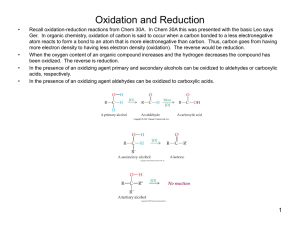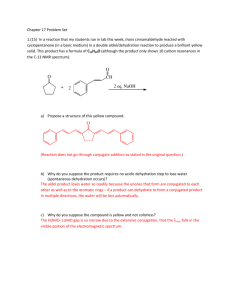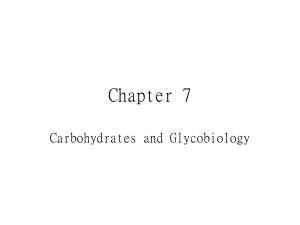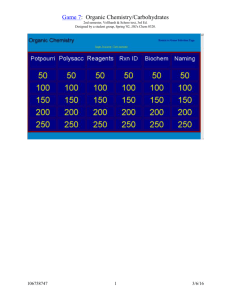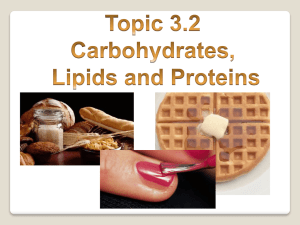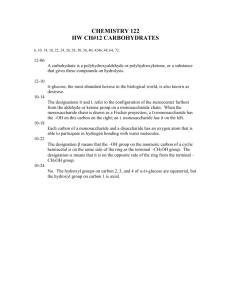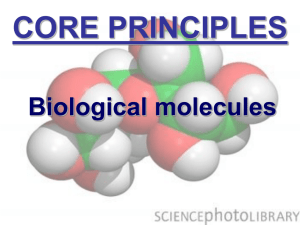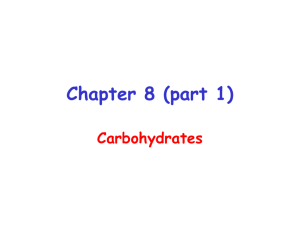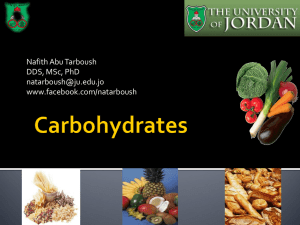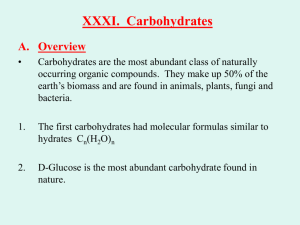CARBOHYDRATES
advertisement
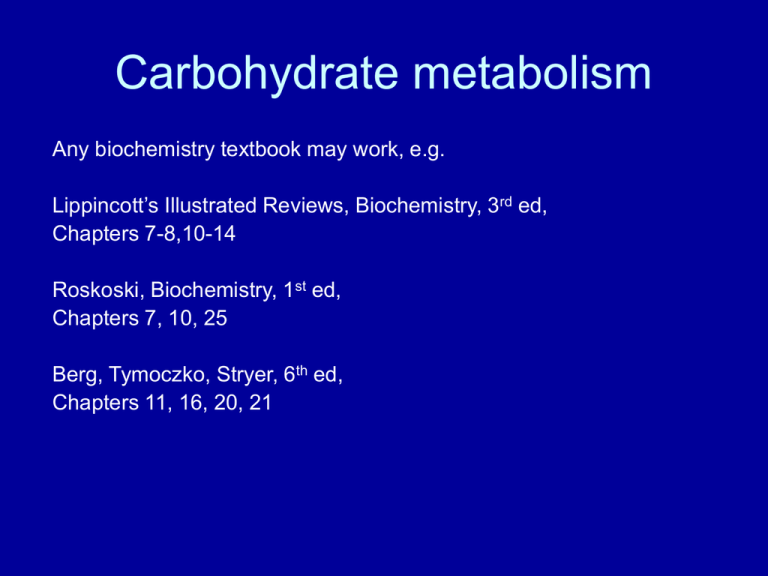
Carbohydrate metabolism Any biochemistry textbook may work, e.g. Lippincott’s Illustrated Reviews, Biochemistry, 3rd ed, Chapters 7-8,10-14 Roskoski, Biochemistry, 1st ed, Chapters 7, 10, 25 Berg, Tymoczko, Stryer, 6th ed, Chapters 11, 16, 20, 21 CARBOHYDRATES Learning objectives: Classify carbohydrates according to their definitions Discuss isomeric properties of carbohydrates Draw structures of the most common carbohydrates Discuss digestion of dietary carbohydrates Sept. 2007 CARBOHYDRATES • The most abundant organic molecules in nature • Provide a significant fraction of the energy in the diet of most organisms • Important source of energy for cells • Can act as a storage form of energy • Can be structural components of many organisms • Can be cell-membrane components mediating intercellular communication • Can be cell-surface antigens • Can be part of the body’s extracellular ground substance • Can be associated with proteins and lipids • Part of RNA, DNA, and several coenzymes (NAD+, NADP+, FAD, CoA) Sept. 2007 CARBOHYDRATES Polyhydroxy aldehydes or ketones, or substances that yield these compounds on hydrolysis Aldehyde group O H C H- C - OH CH2OH Glyceraldehyde CH2OH C O Keto group CH2OH Dihydroxyacetone Carbohydrate with an aldehyde group: Carbohydrate with a ketone group: Aldose Ketose CARBOHYDRATES Polyhydroxy aldehydes or ketones, or substances that yield these compounds on hydrolysis O H C H- C - OH CH2OH Glyceraldehyde CH2OH C O CH2OH Both can be written C3H6O3 or (CH2O)3 Dihydroxyacetone Empirical formula of many simpler carbohydrates: (CH2O)n (hence the name hydrate of carbon) Monosaccharides Polyhydroxy aldehydes or ketones that can’t easily be further hydrolyzed “Simple sugars” Number of carbons 3 4 5 6 7 9 Name Trioses Tetroses Pentoses Hexoses Heptoses Nonoses Example Glyceraldehyde Erythrose Ribose Glucose, Fructose Sedoheptulose Neuraminic acid Oligosaccharides Hydrolyzable polymers of 2-6 monosaccharides Disaccharides composed of 2 monosaccharides Examples: Sucrose, Lactose Polysaccharides Hydrolyzable polymers of > 6 monosaccharides Homopolysaccharides: polymer of a single type of monosaccharide Examples: Glycogen, Cellulose Heteropolysaccharides: polymer of at least 2 types of monosaccharide Example: Glucosaminoglycans ISOMERISM Structural isomers Compounds with the same molecular formula but with different structures Functional group isomers with different functional groups E.g. glyceraldehyde and dihydroxyacetone Positional isomers with substituent groups on different C-atoms E.g. COO--CHOPO3--CH2OH and COO--CHOH-CH2OPO32-Phosphoglycerate 3-Phosphoglycerate ISOMERISM Stereoisomers Compounds with the same molecular formula, functional groups, and position of functional groups but with different conformations cis-trans isomers with different conformation around double bonds H HOOC COOH H COOH C C C C H Fumaric acid (trans) H COOH Maleic acid (cis) ISOMERISM Stereoisomers Compounds with the same molecular formula, functional groups, and position of functional groups but with different conformations optical isomers with different conformation around chiral or asymmetric carbon atoms The carbon C is asymmetric if A, B, D, and E are four different groups B A C E D The four different groups A, B, D, and E can be arranged in space around the C-atom in two different ways to generate two different compounds ISOMERISM Stereoisomers Compounds with the same molecular formula, functional groups, and position of functional groups but with different conformations optical isomers with different conformation around chiral or asymmetric carbon atoms B A C The mirror images can’t be superimposed on each other, i.e. they are different B D D E C E Mirror A The mirror image isomers constitute an enantiomeric pair; one member of the pair is said to be the enantiomer of the other ISOMERISM B A C B D D E C A E Mirror One member of an enantiomeric pair will rotate a plane of polarized light in a clockwise direction. It is said to be dextrorotatory which is labelled (+) The other member of the pair will then rotate the light in a counterclockwise direction. It is said to be levorotatory which is labelled (-) ISOMERISM B A C E Fischer projection formula B D A C D E Perspective formula Reference compound for optical isomers is the simplest monosaccharide with an asymmetric carbon: glyceraldehyde O H C H- C - OH C-atom 1 C-atom 2 (an asymmetric carbon) C-atom 3 CH2OH O H C H- C - OH O H C HO- C - H CH2OH CH2OH D-Glyceraldehyde L-Glyceraldehyde D-Glyceraldehyde CH2OH C O CH2OH Dihydroxyacetone is assigned to be the isomer that has the hydroxyl group on the right when the aldehyde group is at the top in a Fischer projection formula. It is also dextrorotatory, so it is also D(+)-Glyceraldehyde If a compound has n asymmetric carbon atoms then there are 2n different optical isomers Number of carbon atoms 3 4 5 6 3 4 5 6 Aldose/Ketose Aldose Aldose Aldose Aldose Ketose Ketose Ketose Ketose Number of asymmetric carbon atoms 1 2 3 4 0 1 2 3 Number of optical isomers 2 4 8 16 2 4 8 D & L designate absolute configuration of the asymmetric carbon atom farthest from the aldehyde or ketone group CHO Ι H – C – OH Ι H – C - OH Ι CH2OH CHO Ι OH – C – H Ι OH – C - H Ι CH2OH CHO Ι OH – C – H Ι H – C - OH Ι CH2OH CHO Ι H – C – OH Ι OH – C - H Ι CH2OH D-Erythrose L-Erythrose D-Threose L-Threose Optical isomers that are not enantiomers are diastereomers Diastereomers that differ by their configuration on a single asymmetric carbon are epimers CHO Ι H – C – OH Ι HO – C – H Ι H – C – OH Ι H – C – OH Ι CH2OH CHO Ι HO – C – H Ι HO – C – H Ι H – C – OH Ι H – C – OH Ι CH2OH D-Glucose D-Mannose C6H12O6 C6H12O6 CHO Ι H – C – OH Ι HO – C – H Ι HO – C – H Ι H – C – OH Ι CH2OH CH2OH Ι C=O Ι HO – C – H Ι H – C – OH Ι H – C – OH Ι CH2OH CHO Ι HO – C – OH Ι H – C – OH Ι H – C – OH Ι CH2OH D-Galactose D-Fructose D-Ribose C6H12O6 C6H12O6 C5H10O5 Reactions involving aldehyde and keto groups in carbohydrates Aldehyde + Alcohol Hemiacetal Ketone + Alcohol Hemiketal With ring formation involving the aldehyde- or ketone-carbon atom, this carbon atom also becomes asymmetric, giving two possible isomers called anomers The carbon atom is the anomeric carbon The hydroxyl group bound to the anomeric carbon is the anomeric hydroxyl group. In Haworth formulas of D-pentoses and D-hexoses, the α-anomer has the anomeric hydroxyl written below the ring plane the β-anomer has the anomeric hydroxyl written above the ring plane 6-membered ring: Pyranose 5-membered ring: Furanose Mutarotation: Spontaneous conversion of one anomer to the other CH2OH CH2OH O H H OH OH H H OH H OH H α-anomer O H OH CHO Ι H – C – OH Ι HO – C – H Ι H – C – OH Ι H – C – OH Ι CH2OH OH OH H H H OH β-anomer D-Glucose Equilibrium: 36% α-anomer, 63% β-anomer, <1% open-chain form Learn (know) these structures CH2OH O H H OH OH H OH H H D-Glucopyranose H H OH OH CH2OH H H D-Fructopyranose H OH D-Galactopyranose OH O H H H OH OH H H OH H H D-Mannopyranose CH2OH O H OH H H O OH OH OH OH OH CH2OH O H H OH CH2OH CH2OH OH D-Ribofuranose Reducing sugars Carbohydrate with a free or potentially free aldehyde or ketone group CH2OH O H H OH OH OH H H H OH CHO Ι H – C – OH Ι HO – C – H Ι H – C – OH Ι H – C – OH Ι CH2OH CH2OH Ι C=O Ι HO – C – H Ι H – C – OH Ι H – C – OH Ι CH2OH D-Fructose OH - Cu2+ Cu+ Cu2O H2O, OHBenedict’s solution HOCH ΙΙ H – C – OH Ι HO – C – H Ι H – C – OH Ι H – C – OH Ι CH2OH Enediol OH - CHO Ι H – C – OH Ι HO – C – H Ι H – C – OH Ι H – C – OH Ι CH2OH D-Glucose COOH Ι H – C – OH Ι HO – C – H Ι H – C – OH Ι H – C – OH Ι CH2OH Glycosidic bonds Bond formed between the anomeric carbon of a carbohydrate and the hydroxyl oxygen atom of an alcohol (O-glycosidic bond) or the nitrogen of an amine (N-glycosidic bond) Glycosidic bonds between monosaccharides yields oligo- and polysaccharides After glycosidic bond formation, the ring formation involving the anomeric carbon is stabilized with no potentially free aldehyde or keto groups O-glycosidic bonds R’’ O OH C R O + HO – R’’ H (R’) Hemiacetal (Hemiketal) O C R Alcohol Acetal (Ketal) + H 2O H (R’) Water Glycosidic bonds Lactose: Maltose: Isomaltose: Sucrose: β-D-galactopyranosyl-(1→4)- D-glucopyranose α-D-glucopyranosyl-(1→4)- D-glucopyranose α-D-glucopyranosyl-(1→6)- D-glucopyranose α-D-glucopyranosyl-(1→2)- D-fructofuranose Glycosidic bonds Lactose, glucose and isomaltose are reducing sugars with a non-reducing and reducing end Sucrose is a non-reducing sugar Model of cellulose molecules in a microfibril Glucosaminoglycans Large complexes of negatively charged heteropolysaccharide chains Typically associated with a small (<5%) amount of protein forming proteoglycans Properties Can bind large amounts of water Gel-like matrix Viscous Lubricating Shock absorbing Glucosaminoglycans Repeating disaccharide units [acidic sugar – amino sugar]n O Amino sugar is D-glucosamine or D-galactosamine with the amino group usually acetylated Acidic sugar is D-gluconic acid or L-iduronic acid Hydroxyl or amino groups may be sulfated Carboxyl groups and sulfate groups make glycosaminoglycans negatively charged at physiological pH Carbohydrates of glycoproteins Glycoproteins contain less carbohydrate than proteoglycans. Carbohydrates can be attached to the amide nitrogen in the side chain of asparagine (N-linkage) or to the hydroxyl oxygen of serine or threonine (O-linkage) Carbohydrates of glycoproteins Cell-surface molecules antigen determinants mediator of cell-cell interaction attachment sites for vira Carbohydrates of glycoproteins Most proteins in serum are glycosylated Example: Erythropoietin Glycosylation enhances stability of erytropoietin in blood Carbohydrates of glycoproteins Several monosaccharide building blocks (e.g. glucose, galactose, mannose, N-acetyl glucosamine, N-acetyl galactosamine, N-acetyl mannoseamine, fucose, N-acetylneuraminic acid) Branching Several possible glycosidic bonds Several potential glycosylation sites in glycoproteins Great structural complexity! Dietary carbohydrates • Starch • Sucrose • Glucose and fructose • Lactose • Cellulose • Other plant polysaccharides Digestible Non-digestible by humans Only monosaccharides are absorbed into the bloodstream from the gut. Digestion of carbohydrates involves their hydrolysis into monosaccharides Digestive Enzymes Enzymes for carbohydrate digestion Enzyme Source Substrate α-Amylase Salivary gland Pancreas Small intestine Small intestine Small intestine Small intestine Small intestine Starch, glycogen Oligosaccharides Dextrinase Isomaltase Maltase Lactase Sucrase Lactase deficiency produces lactose intolerance Oligosaccharides α-1,6-glucosides Maltose Lactose Sucrose Products Glucose Glucose Glucose Galactose, glucose Fructose, glucose Absorption of monosaccharides by intestinal mucosal cells Major monosaccharides Glucose, galactose, fructose Entry into mucosal cells from intestinal lumen Active transport of glucose and galactose with a concurrent uptake of Na+ ions Facilitated transport of fructose via transporter protein GLUT-5 Entry into the portal circulation from mucosal cells Facilitated transport via transporter protein GLUT-2 Blood glucose concentrations Measured in mmol/L = mM or in mg/dL Conversion factor: 1 mM = 18 mg/dL Normal plasma glucose concentrations roughly 3.9 – 8.3 mM Hypoglycemia: < 2.2 mM Diabetes: > 7.0 mM (fasting) > 11.1 mM 2 h after ingestion of 75 g glucose All cells can use glucose as an energy source Brain cells and erythrocytes require glucose as an energy source
